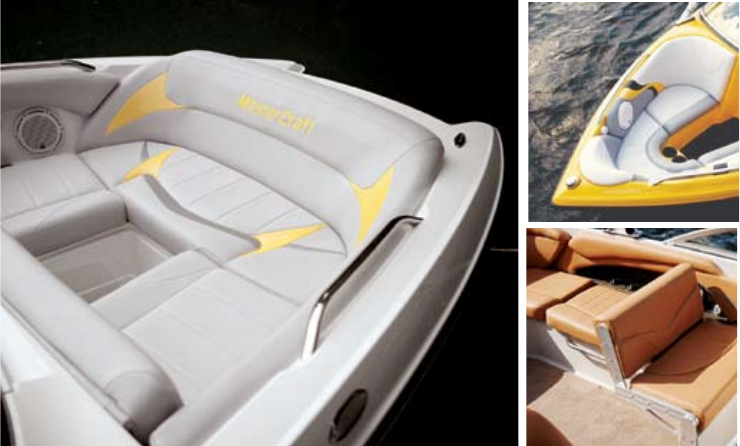User manual

cleaning the boat
Periodic cleaning is the best way to keep your boat looking like
new. Regular washing and waxing keep dirt and build-up from
deteriorating the nish. Keeping your boat in a showroom-new
condition results in personal satisfaction and higher resale value.
e boat is made of berglass-reinforced plastic resin material
that is easy to clean and care for. Several layers of resin material
are chemically bonded together to form the hull. e smooth
outside surface of the hull is a layer of gel coat resin. While the
gel coat is solid color, the thickness of the layer is only a few
millimeters thick—like paint on a car but much tougher, and
chemically bonded.
Beneath the gel coat surface is a series of layers of chemical
resin, berglass mat and woven roving. It is these layers that
give the boat its strength and maintain the hull shape. e boat
bottom also uses special core-mat material for its strength-to-
weight and superior marine performance.
Even though MasterCra has carefully craed boats from
resilient materials, it is still the responsibility of the boat owner
to perform regular and routine cleaning maintenance to ensure
that the boat exterior, interior and components retain both ap-
pearance and strength of materials.
Hull
When washing the boat, use a mild detergent, such as Dawn
or Ivory dish soap, or similar commercially-produced deter-
gent, and warm water solution. DO NOT use abrasive cleaners,
solvents, ammonia or chlorine, as these will damage the gel coat
surface. Under extreme conditions, special cleaners may be used
to remove marine growth from the hull. (See an authorized Mas-
terCra service department for further instructions.)
Upholstery
While the vinyl is made to withstand the
elements, it is important to care for vinyl
by keeping it clean at all times. Many
substances may stain the vinyl if le
untreated over a period of time. Remem-
ber to remove any contaminant and clean
vinyl immediately.
Regular washing with mild detergent (see
attached information) and warm water
or vinyl cleaners is sucient to keep the
cushion and vinyl coverings in good
condition. Do not soak the cushion, and
dry thoroughly aer washing to prevent
mildew accumulations when the boat is
covered. Spray the cushions with a mil-
dew repellent and prop them up in the
boat when it is covered to take advantage
of air circulation.
MasterCra vinyl is made to withstand the eects of sun, heat,
acid rain and soiling, under normal conditions, but this does not
preclude the cleaning requirements. Please consult the following
cleaning recommendations before cleaning your upholstery.
Certain household cleaners, powdered abrasives, steel wool,
and industrial cleaners may cause damage and discoloration,
and are not recommended for use. Dry cleaning uids and
lacquer solvents should not be used as they will remove the
printed pattern and gloss. Waxes are not recommended, as
many contain dyes and solvents that can permanently damage
the vinyl’s protective coating.
In some instances, consumers have reported the appearance of a
pink stain on vinyl that is resistant to various cleaning methods.
Although there can be other causes for pink staining in vinyls,
most pink stains are caused by dyes produced by micro-organ-
isms. ese dyes are metabolic products of the micro-organisms,
otherwise known as a form of fungi.
It is virtually impossible for consumers to avoid these micro-
organisms as they exist in the atmosphere, which are more
prevalent in high-humidity areas. Rain cleanses the air, with the
result being that the micro-organisms are deposited on items
such as marine vinyl.
While the vinyl is treated to resist the growth of micro-organ-
isms (meaning the vinyl is not a food source), the stain results
from failure to properly clean and maintain the vinyl. is
means that aer use, the upholstery must be cleaned with a so
brush and warm soapy water, followed by a thorough rinse with
clean water.
is situation is worsened if the boat is stored without proper
ventilation or if the boat cover is put on while the vinyl is still
wet, creating a situation in which all forms of fungi (mold and
mildew) thrive.
MasterCraft 2009 Owner’s Manual - Page 13-1










